Writing in Publication: Peer Review Systems, Metrics, and Open Access
VerifiedAdded on 2021/04/24
|13
|3638
|29
Report
AI Summary
This report provides a comprehensive overview of the writing process in academic publications. It begins with an introduction highlighting the importance of publication in professional domains like healthcare and nursing, emphasizing the need for reliable and verifiable information. The report then details the typical publication process, including editorial review, peer review, production, and administrative steps. It emphasizes the significance of quality assurance, explaining how it ensures the validity and reliability of academic articles and addresses challenges like increasing research volume and competition. Different types of peer review systems, such as single-blind, double-blind, and open review, are discussed, along with their advantages. The report also addresses open access publication, including the green and gold open access models, and the importance of publication metrics in measuring the impact and utilization of academic work. Various publication metrics, such as the number of publications, author status, and citation reports, are also discussed. This report serves as a valuable resource for understanding the complexities of academic publishing.
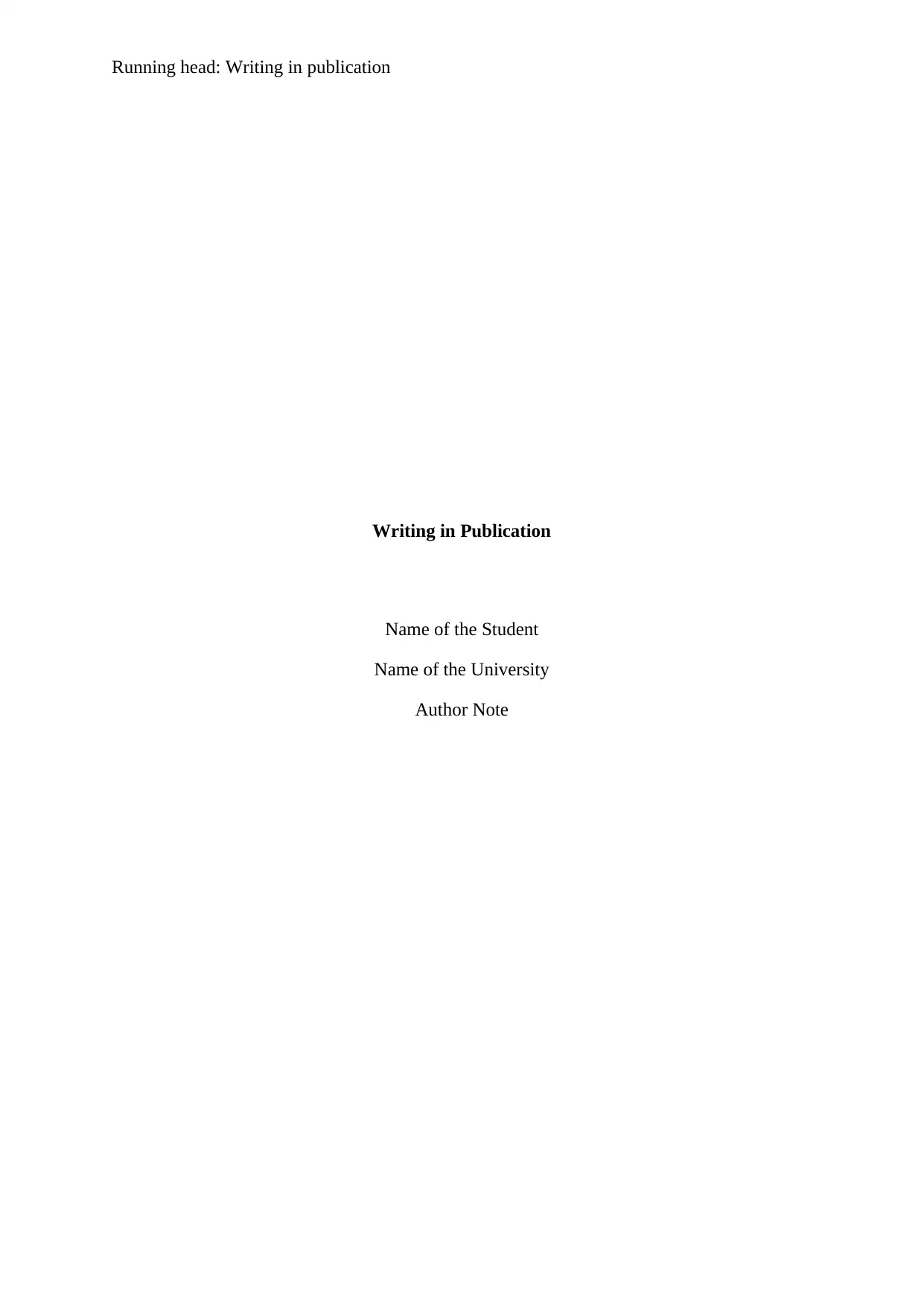
Running head: Writing in publication
Writing in Publication
Name of the Student
Name of the University
Author Note
Writing in Publication
Name of the Student
Name of the University
Author Note
Paraphrase This Document
Need a fresh take? Get an instant paraphrase of this document with our AI Paraphraser
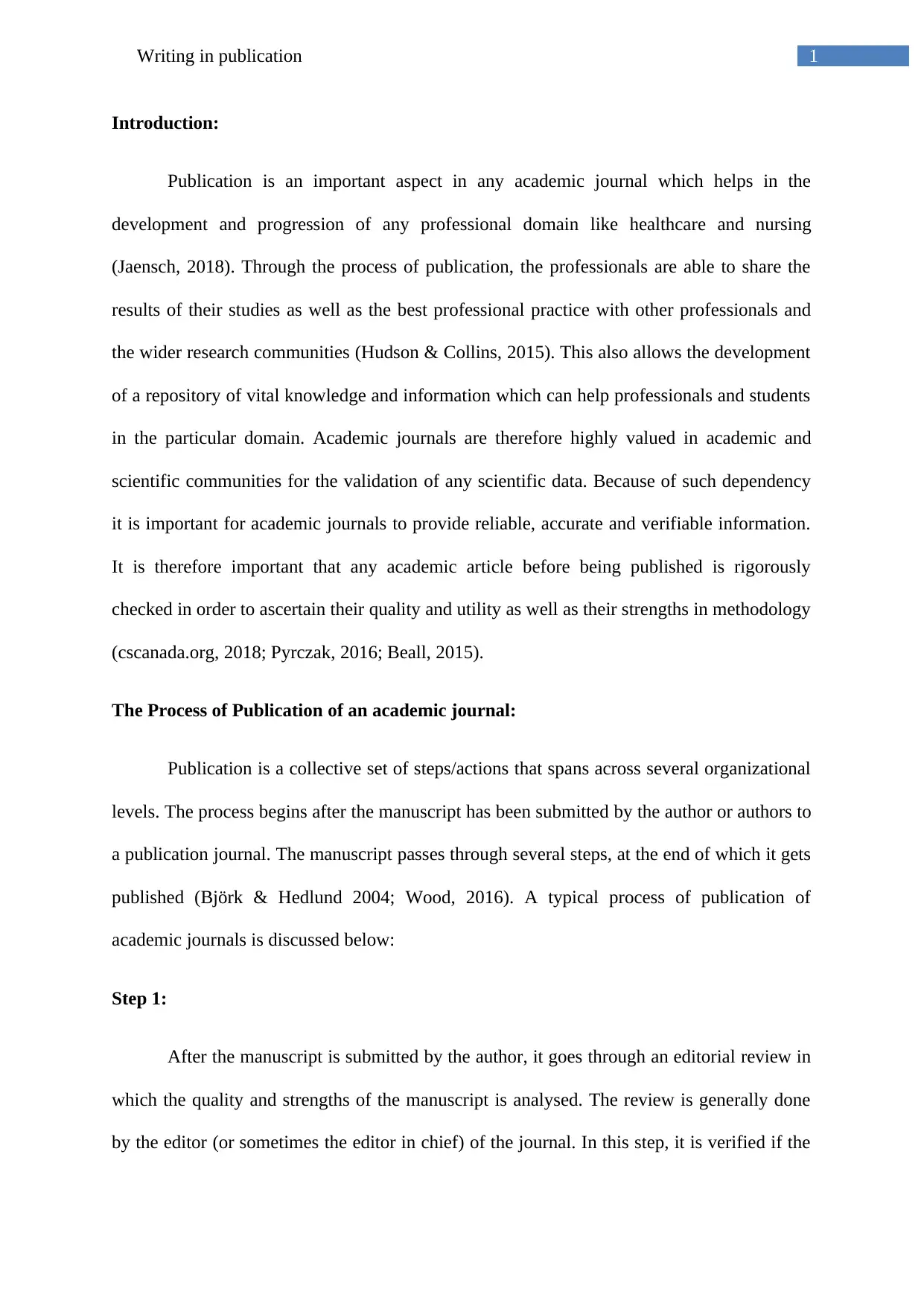
1Writing in publication
Introduction:
Publication is an important aspect in any academic journal which helps in the
development and progression of any professional domain like healthcare and nursing
(Jaensch, 2018). Through the process of publication, the professionals are able to share the
results of their studies as well as the best professional practice with other professionals and
the wider research communities (Hudson & Collins, 2015). This also allows the development
of a repository of vital knowledge and information which can help professionals and students
in the particular domain. Academic journals are therefore highly valued in academic and
scientific communities for the validation of any scientific data. Because of such dependency
it is important for academic journals to provide reliable, accurate and verifiable information.
It is therefore important that any academic article before being published is rigorously
checked in order to ascertain their quality and utility as well as their strengths in methodology
(cscanada.org, 2018; Pyrczak, 2016; Beall, 2015).
The Process of Publication of an academic journal:
Publication is a collective set of steps/actions that spans across several organizational
levels. The process begins after the manuscript has been submitted by the author or authors to
a publication journal. The manuscript passes through several steps, at the end of which it gets
published (Björk & Hedlund 2004; Wood, 2016). A typical process of publication of
academic journals is discussed below:
Step 1:
After the manuscript is submitted by the author, it goes through an editorial review in
which the quality and strengths of the manuscript is analysed. The review is generally done
by the editor (or sometimes the editor in chief) of the journal. In this step, it is verified if the
Introduction:
Publication is an important aspect in any academic journal which helps in the
development and progression of any professional domain like healthcare and nursing
(Jaensch, 2018). Through the process of publication, the professionals are able to share the
results of their studies as well as the best professional practice with other professionals and
the wider research communities (Hudson & Collins, 2015). This also allows the development
of a repository of vital knowledge and information which can help professionals and students
in the particular domain. Academic journals are therefore highly valued in academic and
scientific communities for the validation of any scientific data. Because of such dependency
it is important for academic journals to provide reliable, accurate and verifiable information.
It is therefore important that any academic article before being published is rigorously
checked in order to ascertain their quality and utility as well as their strengths in methodology
(cscanada.org, 2018; Pyrczak, 2016; Beall, 2015).
The Process of Publication of an academic journal:
Publication is a collective set of steps/actions that spans across several organizational
levels. The process begins after the manuscript has been submitted by the author or authors to
a publication journal. The manuscript passes through several steps, at the end of which it gets
published (Björk & Hedlund 2004; Wood, 2016). A typical process of publication of
academic journals is discussed below:
Step 1:
After the manuscript is submitted by the author, it goes through an editorial review in
which the quality and strengths of the manuscript is analysed. The review is generally done
by the editor (or sometimes the editor in chief) of the journal. In this step, it is verified if the
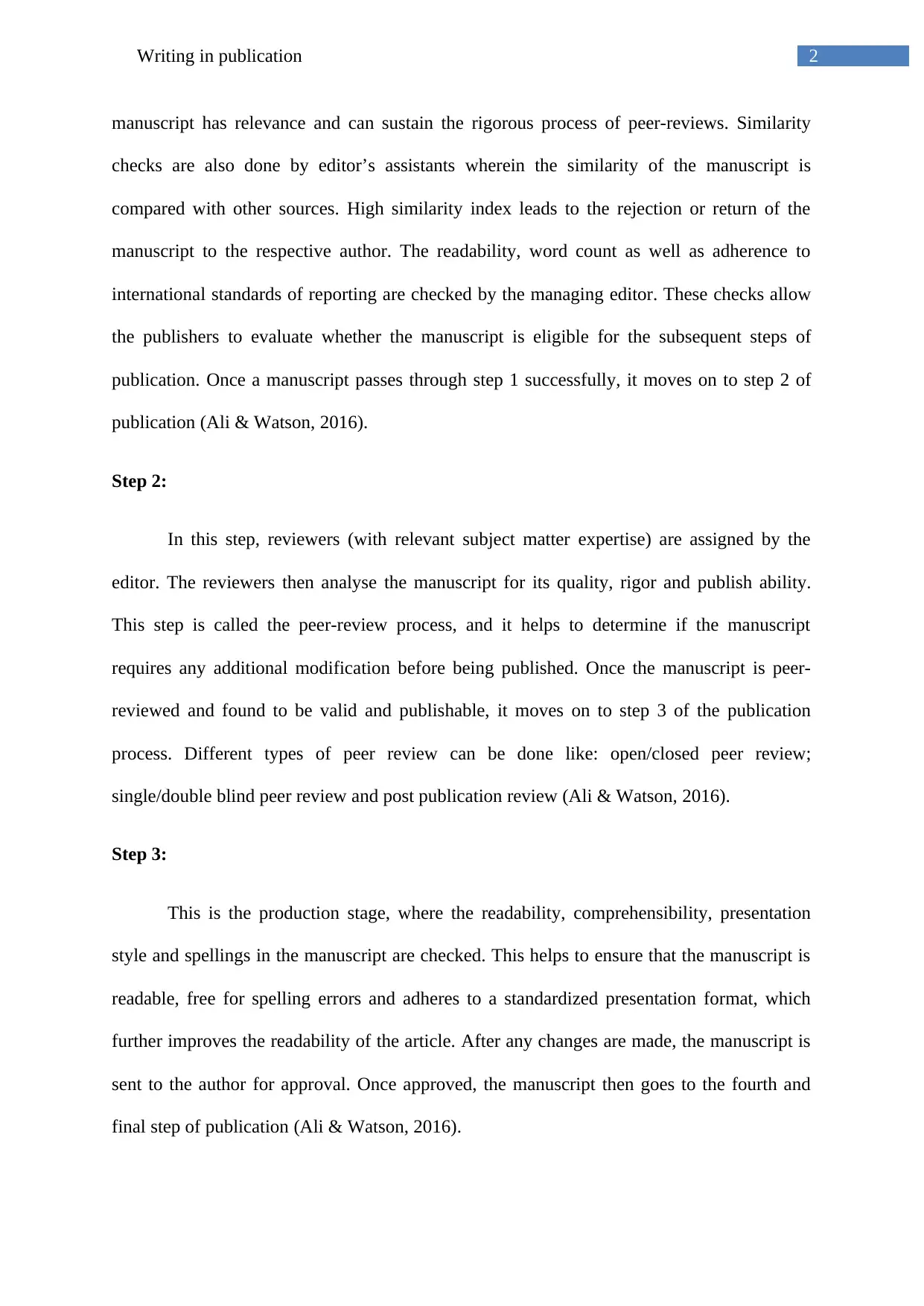
2Writing in publication
manuscript has relevance and can sustain the rigorous process of peer-reviews. Similarity
checks are also done by editor’s assistants wherein the similarity of the manuscript is
compared with other sources. High similarity index leads to the rejection or return of the
manuscript to the respective author. The readability, word count as well as adherence to
international standards of reporting are checked by the managing editor. These checks allow
the publishers to evaluate whether the manuscript is eligible for the subsequent steps of
publication. Once a manuscript passes through step 1 successfully, it moves on to step 2 of
publication (Ali & Watson, 2016).
Step 2:
In this step, reviewers (with relevant subject matter expertise) are assigned by the
editor. The reviewers then analyse the manuscript for its quality, rigor and publish ability.
This step is called the peer-review process, and it helps to determine if the manuscript
requires any additional modification before being published. Once the manuscript is peer-
reviewed and found to be valid and publishable, it moves on to step 3 of the publication
process. Different types of peer review can be done like: open/closed peer review;
single/double blind peer review and post publication review (Ali & Watson, 2016).
Step 3:
This is the production stage, where the readability, comprehensibility, presentation
style and spellings in the manuscript are checked. This helps to ensure that the manuscript is
readable, free for spelling errors and adheres to a standardized presentation format, which
further improves the readability of the article. After any changes are made, the manuscript is
sent to the author for approval. Once approved, the manuscript then goes to the fourth and
final step of publication (Ali & Watson, 2016).
manuscript has relevance and can sustain the rigorous process of peer-reviews. Similarity
checks are also done by editor’s assistants wherein the similarity of the manuscript is
compared with other sources. High similarity index leads to the rejection or return of the
manuscript to the respective author. The readability, word count as well as adherence to
international standards of reporting are checked by the managing editor. These checks allow
the publishers to evaluate whether the manuscript is eligible for the subsequent steps of
publication. Once a manuscript passes through step 1 successfully, it moves on to step 2 of
publication (Ali & Watson, 2016).
Step 2:
In this step, reviewers (with relevant subject matter expertise) are assigned by the
editor. The reviewers then analyse the manuscript for its quality, rigor and publish ability.
This step is called the peer-review process, and it helps to determine if the manuscript
requires any additional modification before being published. Once the manuscript is peer-
reviewed and found to be valid and publishable, it moves on to step 3 of the publication
process. Different types of peer review can be done like: open/closed peer review;
single/double blind peer review and post publication review (Ali & Watson, 2016).
Step 3:
This is the production stage, where the readability, comprehensibility, presentation
style and spellings in the manuscript are checked. This helps to ensure that the manuscript is
readable, free for spelling errors and adheres to a standardized presentation format, which
further improves the readability of the article. After any changes are made, the manuscript is
sent to the author for approval. Once approved, the manuscript then goes to the fourth and
final step of publication (Ali & Watson, 2016).
⊘ This is a preview!⊘
Do you want full access?
Subscribe today to unlock all pages.

Trusted by 1+ million students worldwide
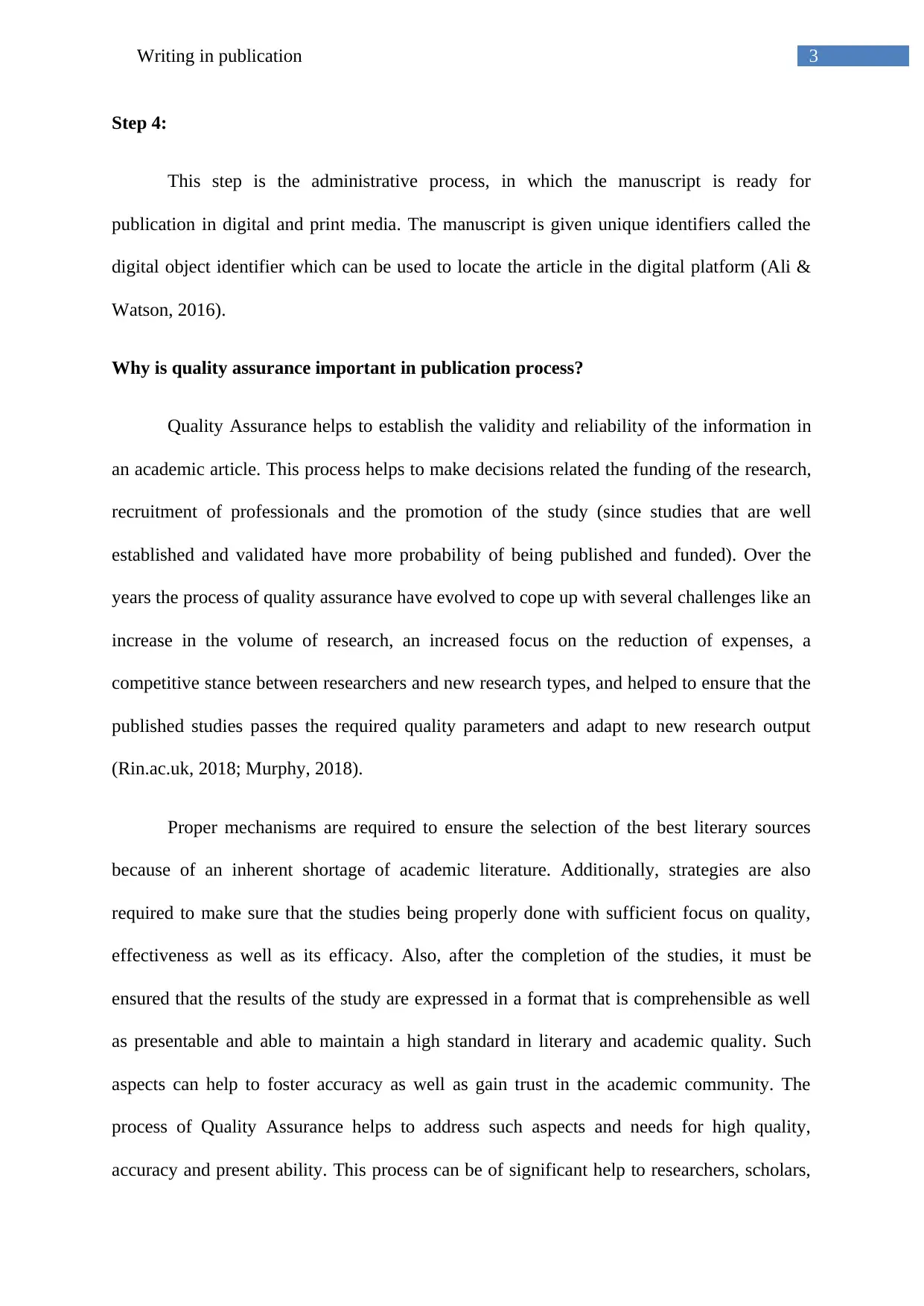
3Writing in publication
Step 4:
This step is the administrative process, in which the manuscript is ready for
publication in digital and print media. The manuscript is given unique identifiers called the
digital object identifier which can be used to locate the article in the digital platform (Ali &
Watson, 2016).
Why is quality assurance important in publication process?
Quality Assurance helps to establish the validity and reliability of the information in
an academic article. This process helps to make decisions related the funding of the research,
recruitment of professionals and the promotion of the study (since studies that are well
established and validated have more probability of being published and funded). Over the
years the process of quality assurance have evolved to cope up with several challenges like an
increase in the volume of research, an increased focus on the reduction of expenses, a
competitive stance between researchers and new research types, and helped to ensure that the
published studies passes the required quality parameters and adapt to new research output
(Rin.ac.uk, 2018; Murphy, 2018).
Proper mechanisms are required to ensure the selection of the best literary sources
because of an inherent shortage of academic literature. Additionally, strategies are also
required to make sure that the studies being properly done with sufficient focus on quality,
effectiveness as well as its efficacy. Also, after the completion of the studies, it must be
ensured that the results of the study are expressed in a format that is comprehensible as well
as presentable and able to maintain a high standard in literary and academic quality. Such
aspects can help to foster accuracy as well as gain trust in the academic community. The
process of Quality Assurance helps to address such aspects and needs for high quality,
accuracy and present ability. This process can be of significant help to researchers, scholars,
Step 4:
This step is the administrative process, in which the manuscript is ready for
publication in digital and print media. The manuscript is given unique identifiers called the
digital object identifier which can be used to locate the article in the digital platform (Ali &
Watson, 2016).
Why is quality assurance important in publication process?
Quality Assurance helps to establish the validity and reliability of the information in
an academic article. This process helps to make decisions related the funding of the research,
recruitment of professionals and the promotion of the study (since studies that are well
established and validated have more probability of being published and funded). Over the
years the process of quality assurance have evolved to cope up with several challenges like an
increase in the volume of research, an increased focus on the reduction of expenses, a
competitive stance between researchers and new research types, and helped to ensure that the
published studies passes the required quality parameters and adapt to new research output
(Rin.ac.uk, 2018; Murphy, 2018).
Proper mechanisms are required to ensure the selection of the best literary sources
because of an inherent shortage of academic literature. Additionally, strategies are also
required to make sure that the studies being properly done with sufficient focus on quality,
effectiveness as well as its efficacy. Also, after the completion of the studies, it must be
ensured that the results of the study are expressed in a format that is comprehensible as well
as presentable and able to maintain a high standard in literary and academic quality. Such
aspects can help to foster accuracy as well as gain trust in the academic community. The
process of Quality Assurance helps to address such aspects and needs for high quality,
accuracy and present ability. This process can be of significant help to researchers, scholars,
Paraphrase This Document
Need a fresh take? Get an instant paraphrase of this document with our AI Paraphraser
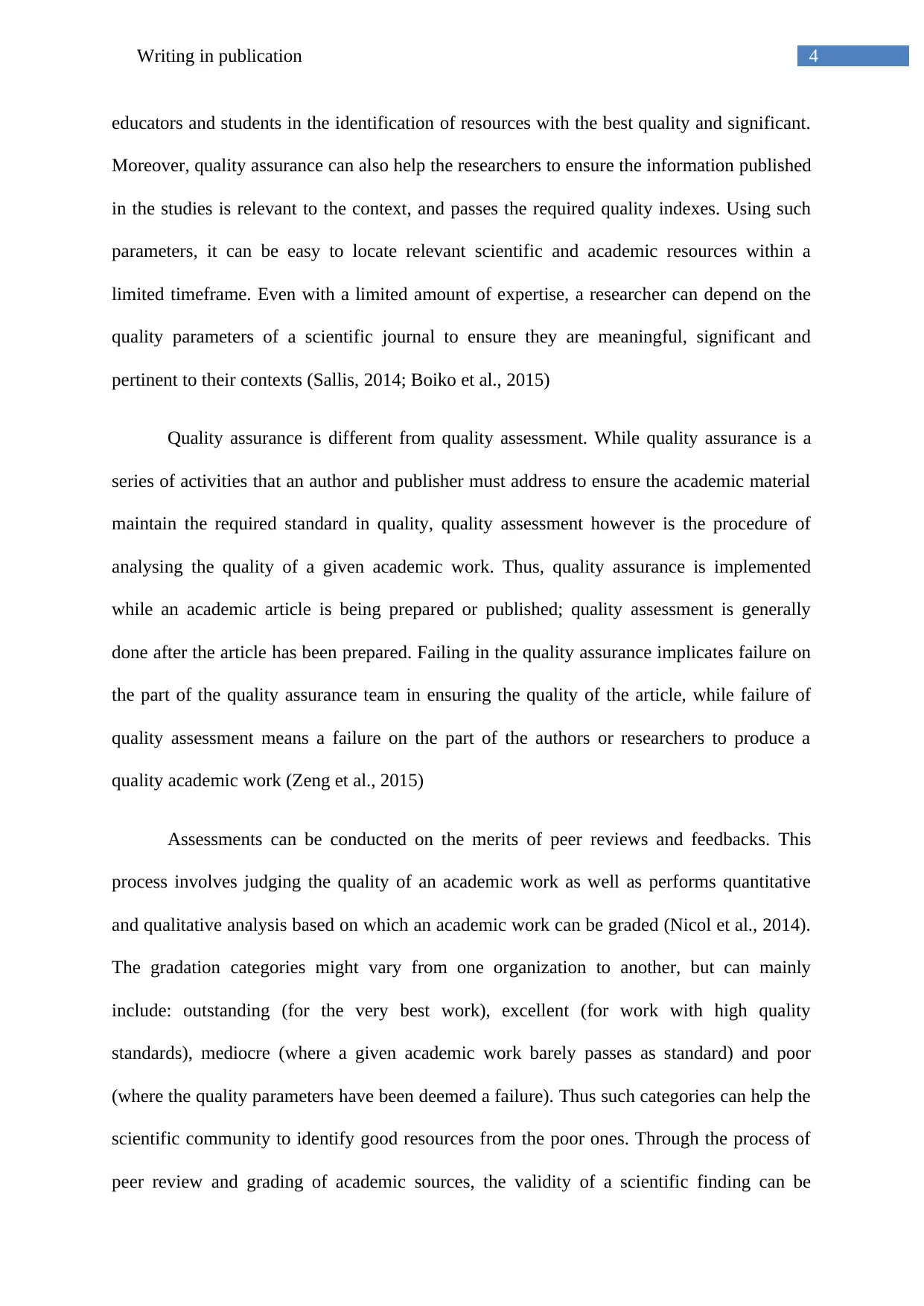
4Writing in publication
educators and students in the identification of resources with the best quality and significant.
Moreover, quality assurance can also help the researchers to ensure the information published
in the studies is relevant to the context, and passes the required quality indexes. Using such
parameters, it can be easy to locate relevant scientific and academic resources within a
limited timeframe. Even with a limited amount of expertise, a researcher can depend on the
quality parameters of a scientific journal to ensure they are meaningful, significant and
pertinent to their contexts (Sallis, 2014; Boiko et al., 2015)
Quality assurance is different from quality assessment. While quality assurance is a
series of activities that an author and publisher must address to ensure the academic material
maintain the required standard in quality, quality assessment however is the procedure of
analysing the quality of a given academic work. Thus, quality assurance is implemented
while an academic article is being prepared or published; quality assessment is generally
done after the article has been prepared. Failing in the quality assurance implicates failure on
the part of the quality assurance team in ensuring the quality of the article, while failure of
quality assessment means a failure on the part of the authors or researchers to produce a
quality academic work (Zeng et al., 2015)
Assessments can be conducted on the merits of peer reviews and feedbacks. This
process involves judging the quality of an academic work as well as performs quantitative
and qualitative analysis based on which an academic work can be graded (Nicol et al., 2014).
The gradation categories might vary from one organization to another, but can mainly
include: outstanding (for the very best work), excellent (for work with high quality
standards), mediocre (where a given academic work barely passes as standard) and poor
(where the quality parameters have been deemed a failure). Thus such categories can help the
scientific community to identify good resources from the poor ones. Through the process of
peer review and grading of academic sources, the validity of a scientific finding can be
educators and students in the identification of resources with the best quality and significant.
Moreover, quality assurance can also help the researchers to ensure the information published
in the studies is relevant to the context, and passes the required quality indexes. Using such
parameters, it can be easy to locate relevant scientific and academic resources within a
limited timeframe. Even with a limited amount of expertise, a researcher can depend on the
quality parameters of a scientific journal to ensure they are meaningful, significant and
pertinent to their contexts (Sallis, 2014; Boiko et al., 2015)
Quality assurance is different from quality assessment. While quality assurance is a
series of activities that an author and publisher must address to ensure the academic material
maintain the required standard in quality, quality assessment however is the procedure of
analysing the quality of a given academic work. Thus, quality assurance is implemented
while an academic article is being prepared or published; quality assessment is generally
done after the article has been prepared. Failing in the quality assurance implicates failure on
the part of the quality assurance team in ensuring the quality of the article, while failure of
quality assessment means a failure on the part of the authors or researchers to produce a
quality academic work (Zeng et al., 2015)
Assessments can be conducted on the merits of peer reviews and feedbacks. This
process involves judging the quality of an academic work as well as performs quantitative
and qualitative analysis based on which an academic work can be graded (Nicol et al., 2014).
The gradation categories might vary from one organization to another, but can mainly
include: outstanding (for the very best work), excellent (for work with high quality
standards), mediocre (where a given academic work barely passes as standard) and poor
(where the quality parameters have been deemed a failure). Thus such categories can help the
scientific community to identify good resources from the poor ones. Through the process of
peer review and grading of academic sources, the validity of a scientific finding can be
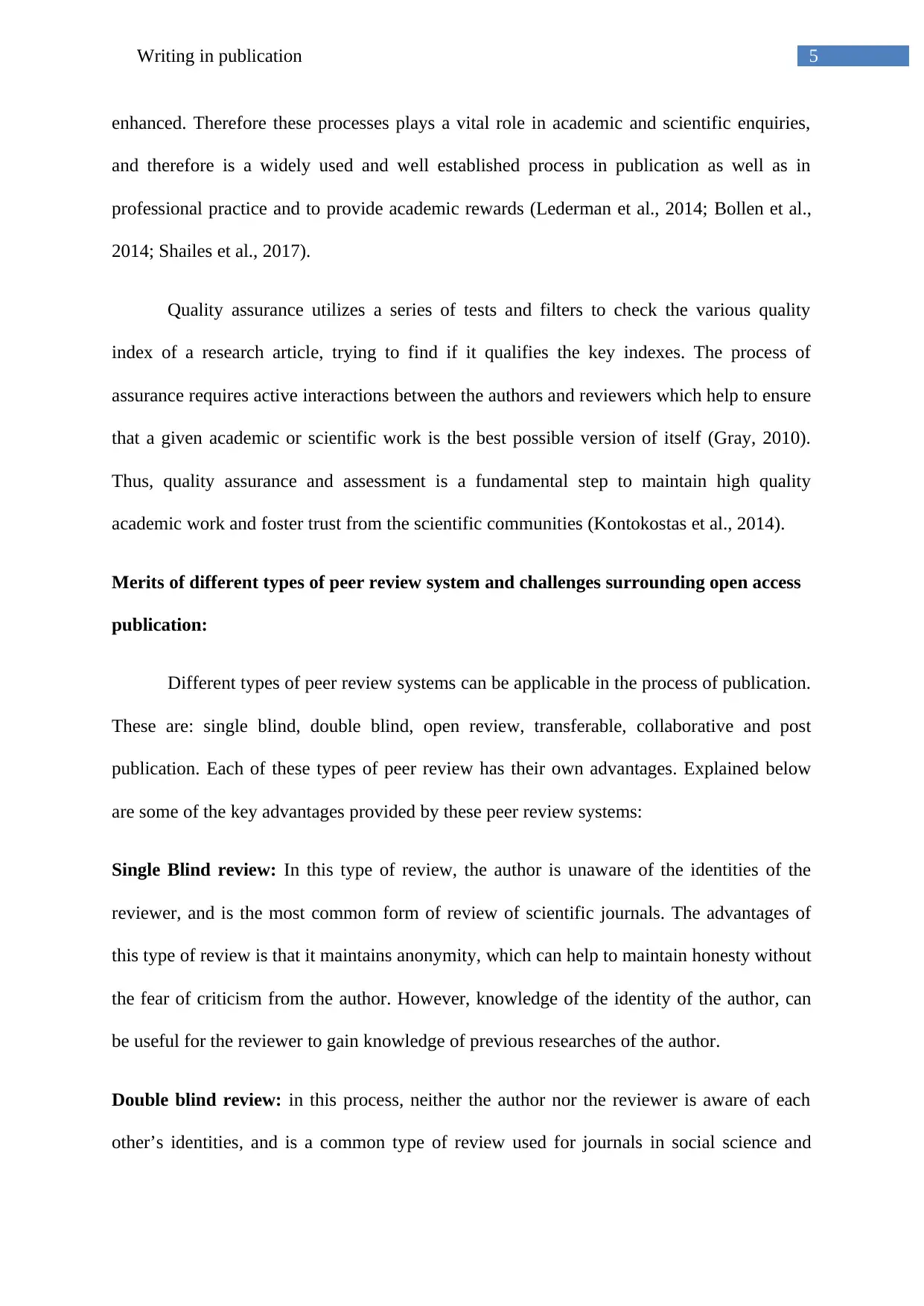
5Writing in publication
enhanced. Therefore these processes plays a vital role in academic and scientific enquiries,
and therefore is a widely used and well established process in publication as well as in
professional practice and to provide academic rewards (Lederman et al., 2014; Bollen et al.,
2014; Shailes et al., 2017).
Quality assurance utilizes a series of tests and filters to check the various quality
index of a research article, trying to find if it qualifies the key indexes. The process of
assurance requires active interactions between the authors and reviewers which help to ensure
that a given academic or scientific work is the best possible version of itself (Gray, 2010).
Thus, quality assurance and assessment is a fundamental step to maintain high quality
academic work and foster trust from the scientific communities (Kontokostas et al., 2014).
Merits of different types of peer review system and challenges surrounding open access
publication:
Different types of peer review systems can be applicable in the process of publication.
These are: single blind, double blind, open review, transferable, collaborative and post
publication. Each of these types of peer review has their own advantages. Explained below
are some of the key advantages provided by these peer review systems:
Single Blind review: In this type of review, the author is unaware of the identities of the
reviewer, and is the most common form of review of scientific journals. The advantages of
this type of review is that it maintains anonymity, which can help to maintain honesty without
the fear of criticism from the author. However, knowledge of the identity of the author, can
be useful for the reviewer to gain knowledge of previous researches of the author.
Double blind review: in this process, neither the author nor the reviewer is aware of each
other’s identities, and is a common type of review used for journals in social science and
enhanced. Therefore these processes plays a vital role in academic and scientific enquiries,
and therefore is a widely used and well established process in publication as well as in
professional practice and to provide academic rewards (Lederman et al., 2014; Bollen et al.,
2014; Shailes et al., 2017).
Quality assurance utilizes a series of tests and filters to check the various quality
index of a research article, trying to find if it qualifies the key indexes. The process of
assurance requires active interactions between the authors and reviewers which help to ensure
that a given academic or scientific work is the best possible version of itself (Gray, 2010).
Thus, quality assurance and assessment is a fundamental step to maintain high quality
academic work and foster trust from the scientific communities (Kontokostas et al., 2014).
Merits of different types of peer review system and challenges surrounding open access
publication:
Different types of peer review systems can be applicable in the process of publication.
These are: single blind, double blind, open review, transferable, collaborative and post
publication. Each of these types of peer review has their own advantages. Explained below
are some of the key advantages provided by these peer review systems:
Single Blind review: In this type of review, the author is unaware of the identities of the
reviewer, and is the most common form of review of scientific journals. The advantages of
this type of review is that it maintains anonymity, which can help to maintain honesty without
the fear of criticism from the author. However, knowledge of the identity of the author, can
be useful for the reviewer to gain knowledge of previous researches of the author.
Double blind review: in this process, neither the author nor the reviewer is aware of each
other’s identities, and is a common type of review used for journals in social science and
⊘ This is a preview!⊘
Do you want full access?
Subscribe today to unlock all pages.

Trusted by 1+ million students worldwide
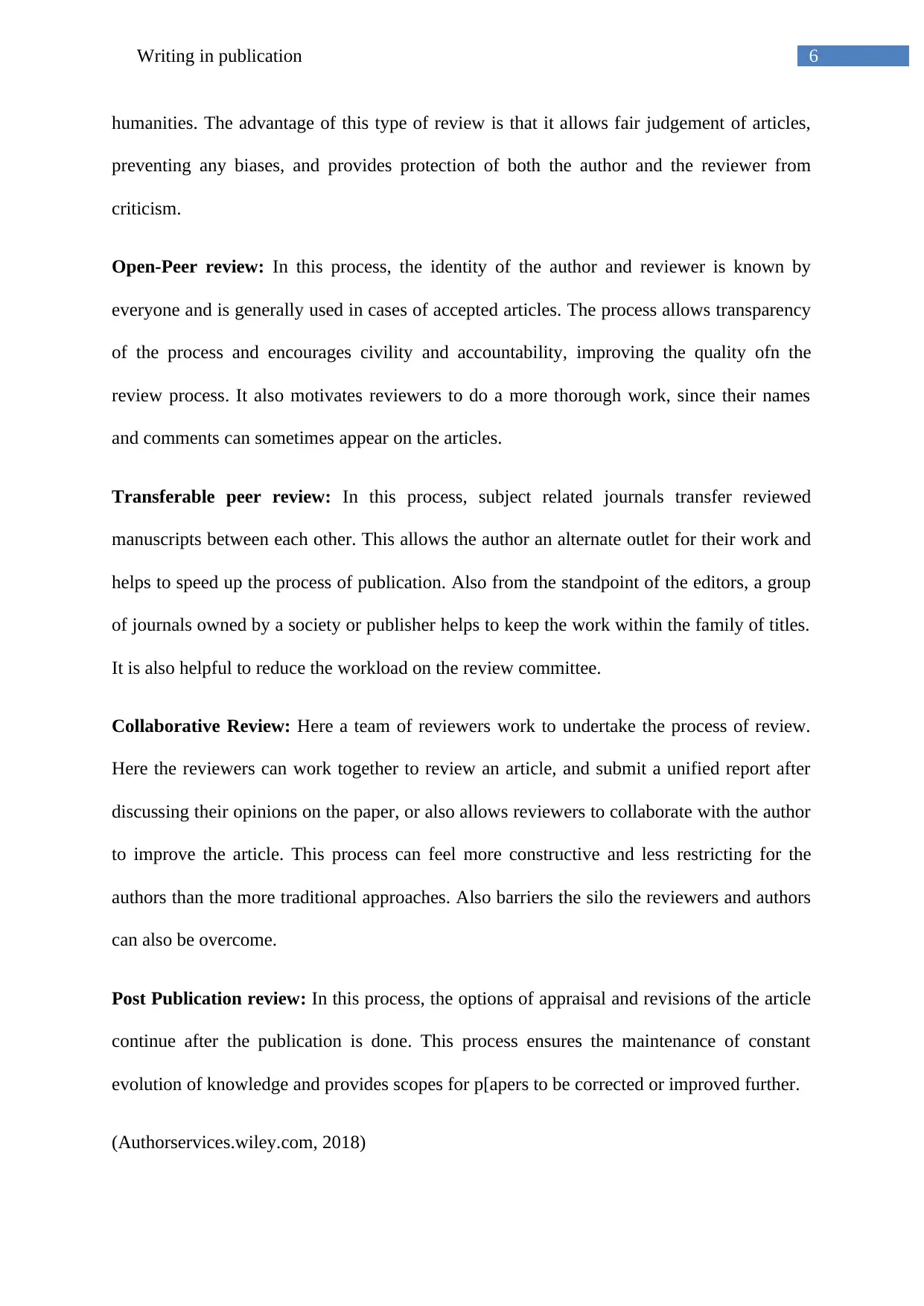
6Writing in publication
humanities. The advantage of this type of review is that it allows fair judgement of articles,
preventing any biases, and provides protection of both the author and the reviewer from
criticism.
Open-Peer review: In this process, the identity of the author and reviewer is known by
everyone and is generally used in cases of accepted articles. The process allows transparency
of the process and encourages civility and accountability, improving the quality ofn the
review process. It also motivates reviewers to do a more thorough work, since their names
and comments can sometimes appear on the articles.
Transferable peer review: In this process, subject related journals transfer reviewed
manuscripts between each other. This allows the author an alternate outlet for their work and
helps to speed up the process of publication. Also from the standpoint of the editors, a group
of journals owned by a society or publisher helps to keep the work within the family of titles.
It is also helpful to reduce the workload on the review committee.
Collaborative Review: Here a team of reviewers work to undertake the process of review.
Here the reviewers can work together to review an article, and submit a unified report after
discussing their opinions on the paper, or also allows reviewers to collaborate with the author
to improve the article. This process can feel more constructive and less restricting for the
authors than the more traditional approaches. Also barriers the silo the reviewers and authors
can also be overcome.
Post Publication review: In this process, the options of appraisal and revisions of the article
continue after the publication is done. This process ensures the maintenance of constant
evolution of knowledge and provides scopes for p[apers to be corrected or improved further.
(Authorservices.wiley.com, 2018)
humanities. The advantage of this type of review is that it allows fair judgement of articles,
preventing any biases, and provides protection of both the author and the reviewer from
criticism.
Open-Peer review: In this process, the identity of the author and reviewer is known by
everyone and is generally used in cases of accepted articles. The process allows transparency
of the process and encourages civility and accountability, improving the quality ofn the
review process. It also motivates reviewers to do a more thorough work, since their names
and comments can sometimes appear on the articles.
Transferable peer review: In this process, subject related journals transfer reviewed
manuscripts between each other. This allows the author an alternate outlet for their work and
helps to speed up the process of publication. Also from the standpoint of the editors, a group
of journals owned by a society or publisher helps to keep the work within the family of titles.
It is also helpful to reduce the workload on the review committee.
Collaborative Review: Here a team of reviewers work to undertake the process of review.
Here the reviewers can work together to review an article, and submit a unified report after
discussing their opinions on the paper, or also allows reviewers to collaborate with the author
to improve the article. This process can feel more constructive and less restricting for the
authors than the more traditional approaches. Also barriers the silo the reviewers and authors
can also be overcome.
Post Publication review: In this process, the options of appraisal and revisions of the article
continue after the publication is done. This process ensures the maintenance of constant
evolution of knowledge and provides scopes for p[apers to be corrected or improved further.
(Authorservices.wiley.com, 2018)
Paraphrase This Document
Need a fresh take? Get an instant paraphrase of this document with our AI Paraphraser
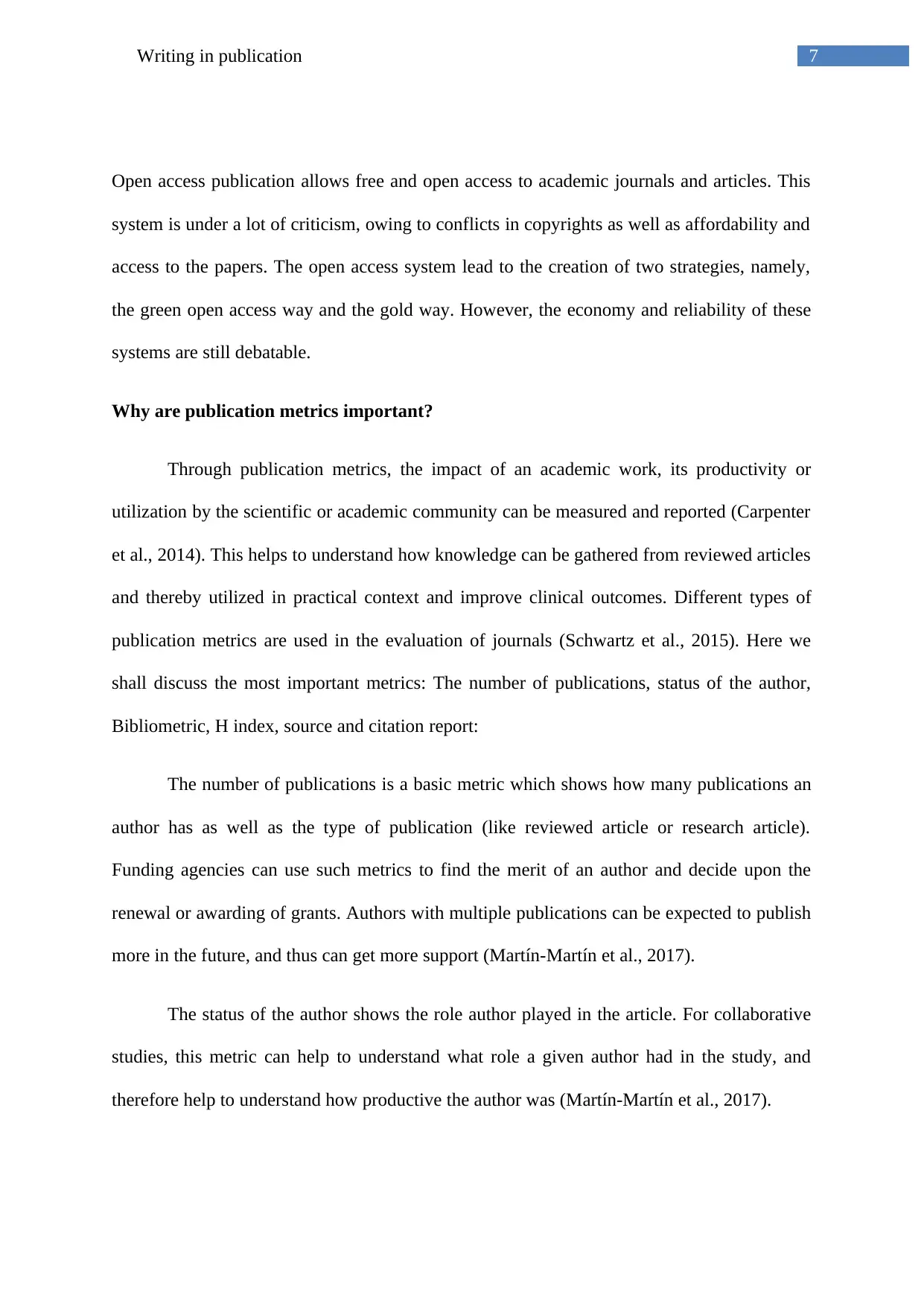
7Writing in publication
Open access publication allows free and open access to academic journals and articles. This
system is under a lot of criticism, owing to conflicts in copyrights as well as affordability and
access to the papers. The open access system lead to the creation of two strategies, namely,
the green open access way and the gold way. However, the economy and reliability of these
systems are still debatable.
Why are publication metrics important?
Through publication metrics, the impact of an academic work, its productivity or
utilization by the scientific or academic community can be measured and reported (Carpenter
et al., 2014). This helps to understand how knowledge can be gathered from reviewed articles
and thereby utilized in practical context and improve clinical outcomes. Different types of
publication metrics are used in the evaluation of journals (Schwartz et al., 2015). Here we
shall discuss the most important metrics: The number of publications, status of the author,
Bibliometric, H index, source and citation report:
The number of publications is a basic metric which shows how many publications an
author has as well as the type of publication (like reviewed article or research article).
Funding agencies can use such metrics to find the merit of an author and decide upon the
renewal or awarding of grants. Authors with multiple publications can be expected to publish
more in the future, and thus can get more support (Martín-Martín et al., 2017).
The status of the author shows the role author played in the article. For collaborative
studies, this metric can help to understand what role a given author had in the study, and
therefore help to understand how productive the author was (Martín-Martín et al., 2017).
Open access publication allows free and open access to academic journals and articles. This
system is under a lot of criticism, owing to conflicts in copyrights as well as affordability and
access to the papers. The open access system lead to the creation of two strategies, namely,
the green open access way and the gold way. However, the economy and reliability of these
systems are still debatable.
Why are publication metrics important?
Through publication metrics, the impact of an academic work, its productivity or
utilization by the scientific or academic community can be measured and reported (Carpenter
et al., 2014). This helps to understand how knowledge can be gathered from reviewed articles
and thereby utilized in practical context and improve clinical outcomes. Different types of
publication metrics are used in the evaluation of journals (Schwartz et al., 2015). Here we
shall discuss the most important metrics: The number of publications, status of the author,
Bibliometric, H index, source and citation report:
The number of publications is a basic metric which shows how many publications an
author has as well as the type of publication (like reviewed article or research article).
Funding agencies can use such metrics to find the merit of an author and decide upon the
renewal or awarding of grants. Authors with multiple publications can be expected to publish
more in the future, and thus can get more support (Martín-Martín et al., 2017).
The status of the author shows the role author played in the article. For collaborative
studies, this metric can help to understand what role a given author had in the study, and
therefore help to understand how productive the author was (Martín-Martín et al., 2017).
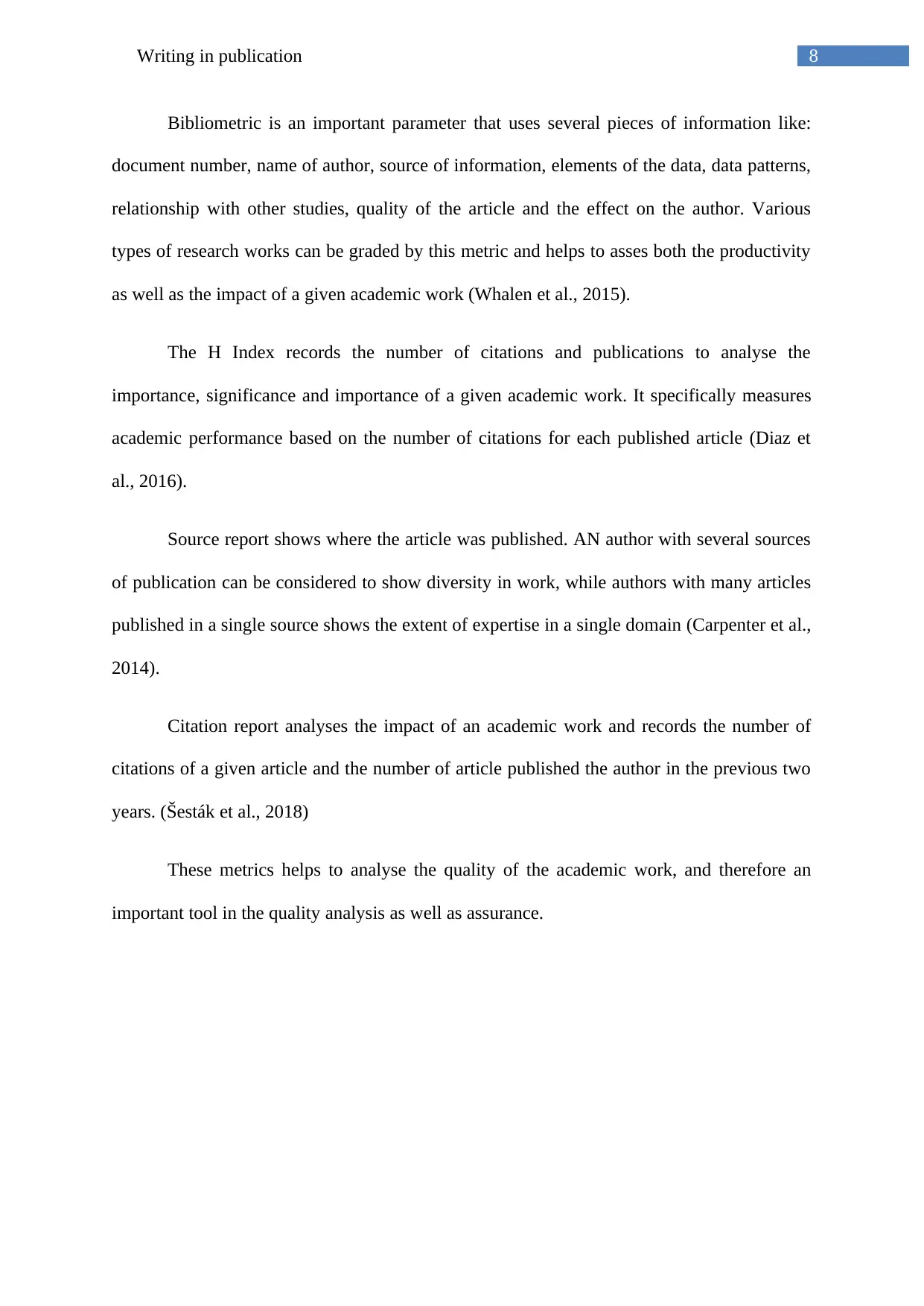
8Writing in publication
Bibliometric is an important parameter that uses several pieces of information like:
document number, name of author, source of information, elements of the data, data patterns,
relationship with other studies, quality of the article and the effect on the author. Various
types of research works can be graded by this metric and helps to asses both the productivity
as well as the impact of a given academic work (Whalen et al., 2015).
The H Index records the number of citations and publications to analyse the
importance, significance and importance of a given academic work. It specifically measures
academic performance based on the number of citations for each published article (Diaz et
al., 2016).
Source report shows where the article was published. AN author with several sources
of publication can be considered to show diversity in work, while authors with many articles
published in a single source shows the extent of expertise in a single domain (Carpenter et al.,
2014).
Citation report analyses the impact of an academic work and records the number of
citations of a given article and the number of article published the author in the previous two
years. (Šesták et al., 2018)
These metrics helps to analyse the quality of the academic work, and therefore an
important tool in the quality analysis as well as assurance.
Bibliometric is an important parameter that uses several pieces of information like:
document number, name of author, source of information, elements of the data, data patterns,
relationship with other studies, quality of the article and the effect on the author. Various
types of research works can be graded by this metric and helps to asses both the productivity
as well as the impact of a given academic work (Whalen et al., 2015).
The H Index records the number of citations and publications to analyse the
importance, significance and importance of a given academic work. It specifically measures
academic performance based on the number of citations for each published article (Diaz et
al., 2016).
Source report shows where the article was published. AN author with several sources
of publication can be considered to show diversity in work, while authors with many articles
published in a single source shows the extent of expertise in a single domain (Carpenter et al.,
2014).
Citation report analyses the impact of an academic work and records the number of
citations of a given article and the number of article published the author in the previous two
years. (Šesták et al., 2018)
These metrics helps to analyse the quality of the academic work, and therefore an
important tool in the quality analysis as well as assurance.
⊘ This is a preview!⊘
Do you want full access?
Subscribe today to unlock all pages.

Trusted by 1+ million students worldwide
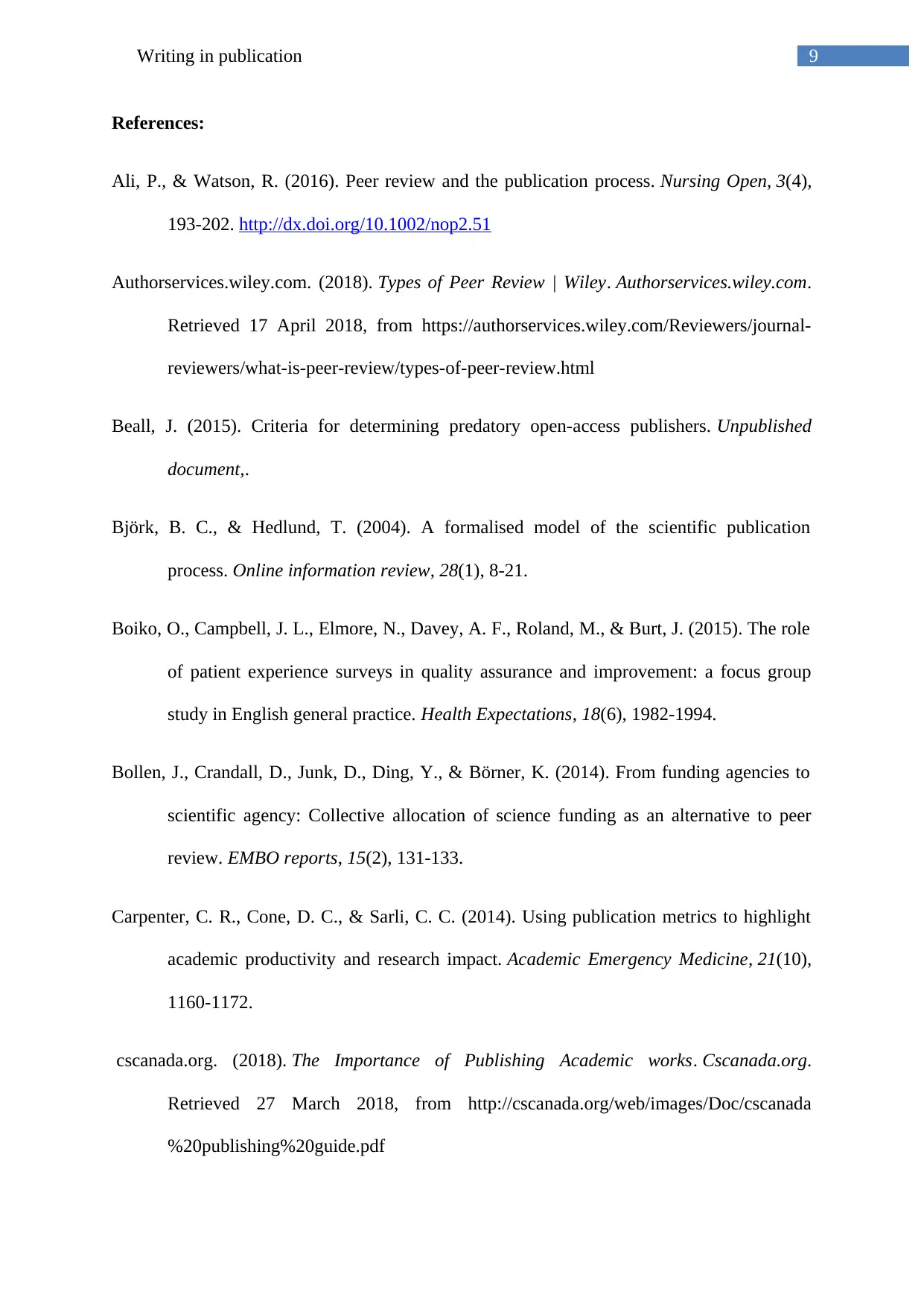
9Writing in publication
References:
Ali, P., & Watson, R. (2016). Peer review and the publication process. Nursing Open, 3(4),
193-202. http://dx.doi.org/10.1002/nop2.51
Authorservices.wiley.com. (2018). Types of Peer Review | Wiley. Authorservices.wiley.com.
Retrieved 17 April 2018, from https://authorservices.wiley.com/Reviewers/journal-
reviewers/what-is-peer-review/types-of-peer-review.html
Beall, J. (2015). Criteria for determining predatory open-access publishers. Unpublished
document,.
Björk, B. C., & Hedlund, T. (2004). A formalised model of the scientific publication
process. Online information review, 28(1), 8-21.
Boiko, O., Campbell, J. L., Elmore, N., Davey, A. F., Roland, M., & Burt, J. (2015). The role
of patient experience surveys in quality assurance and improvement: a focus group
study in English general practice. Health Expectations, 18(6), 1982-1994.
Bollen, J., Crandall, D., Junk, D., Ding, Y., & Börner, K. (2014). From funding agencies to
scientific agency: Collective allocation of science funding as an alternative to peer
review. EMBO reports, 15(2), 131-133.
Carpenter, C. R., Cone, D. C., & Sarli, C. C. (2014). Using publication metrics to highlight
academic productivity and research impact. Academic Emergency Medicine, 21(10),
1160-1172.
cscanada.org. (2018). The Importance of Publishing Academic works. Cscanada.org.
Retrieved 27 March 2018, from http://cscanada.org/web/images/Doc/cscanada
%20publishing%20guide.pdf
References:
Ali, P., & Watson, R. (2016). Peer review and the publication process. Nursing Open, 3(4),
193-202. http://dx.doi.org/10.1002/nop2.51
Authorservices.wiley.com. (2018). Types of Peer Review | Wiley. Authorservices.wiley.com.
Retrieved 17 April 2018, from https://authorservices.wiley.com/Reviewers/journal-
reviewers/what-is-peer-review/types-of-peer-review.html
Beall, J. (2015). Criteria for determining predatory open-access publishers. Unpublished
document,.
Björk, B. C., & Hedlund, T. (2004). A formalised model of the scientific publication
process. Online information review, 28(1), 8-21.
Boiko, O., Campbell, J. L., Elmore, N., Davey, A. F., Roland, M., & Burt, J. (2015). The role
of patient experience surveys in quality assurance and improvement: a focus group
study in English general practice. Health Expectations, 18(6), 1982-1994.
Bollen, J., Crandall, D., Junk, D., Ding, Y., & Börner, K. (2014). From funding agencies to
scientific agency: Collective allocation of science funding as an alternative to peer
review. EMBO reports, 15(2), 131-133.
Carpenter, C. R., Cone, D. C., & Sarli, C. C. (2014). Using publication metrics to highlight
academic productivity and research impact. Academic Emergency Medicine, 21(10),
1160-1172.
cscanada.org. (2018). The Importance of Publishing Academic works. Cscanada.org.
Retrieved 27 March 2018, from http://cscanada.org/web/images/Doc/cscanada
%20publishing%20guide.pdf
Paraphrase This Document
Need a fresh take? Get an instant paraphrase of this document with our AI Paraphraser
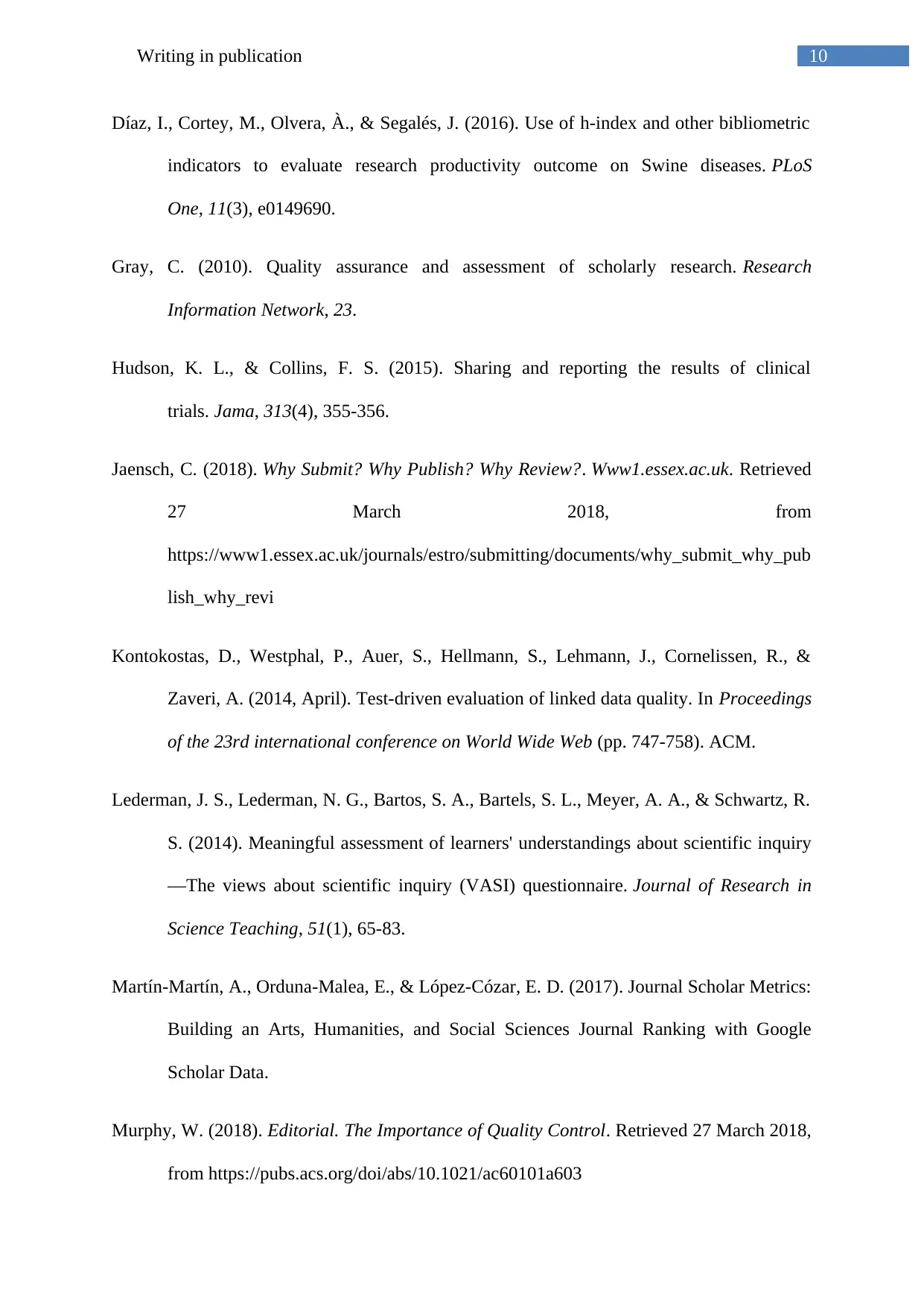
10Writing in publication
Díaz, I., Cortey, M., Olvera, À., & Segalés, J. (2016). Use of h-index and other bibliometric
indicators to evaluate research productivity outcome on Swine diseases. PLoS
One, 11(3), e0149690.
Gray, C. (2010). Quality assurance and assessment of scholarly research. Research
Information Network, 23.
Hudson, K. L., & Collins, F. S. (2015). Sharing and reporting the results of clinical
trials. Jama, 313(4), 355-356.
Jaensch, C. (2018). Why Submit? Why Publish? Why Review?. Www1.essex.ac.uk. Retrieved
27 March 2018, from
https://www1.essex.ac.uk/journals/estro/submitting/documents/why_submit_why_pub
lish_why_revi
Kontokostas, D., Westphal, P., Auer, S., Hellmann, S., Lehmann, J., Cornelissen, R., &
Zaveri, A. (2014, April). Test-driven evaluation of linked data quality. In Proceedings
of the 23rd international conference on World Wide Web (pp. 747-758). ACM.
Lederman, J. S., Lederman, N. G., Bartos, S. A., Bartels, S. L., Meyer, A. A., & Schwartz, R.
S. (2014). Meaningful assessment of learners' understandings about scientific inquiry
—The views about scientific inquiry (VASI) questionnaire. Journal of Research in
Science Teaching, 51(1), 65-83.
Martín-Martín, A., Orduna-Malea, E., & López-Cózar, E. D. (2017). Journal Scholar Metrics:
Building an Arts, Humanities, and Social Sciences Journal Ranking with Google
Scholar Data.
Murphy, W. (2018). Editorial. The Importance of Quality Control. Retrieved 27 March 2018,
from https://pubs.acs.org/doi/abs/10.1021/ac60101a603
Díaz, I., Cortey, M., Olvera, À., & Segalés, J. (2016). Use of h-index and other bibliometric
indicators to evaluate research productivity outcome on Swine diseases. PLoS
One, 11(3), e0149690.
Gray, C. (2010). Quality assurance and assessment of scholarly research. Research
Information Network, 23.
Hudson, K. L., & Collins, F. S. (2015). Sharing and reporting the results of clinical
trials. Jama, 313(4), 355-356.
Jaensch, C. (2018). Why Submit? Why Publish? Why Review?. Www1.essex.ac.uk. Retrieved
27 March 2018, from
https://www1.essex.ac.uk/journals/estro/submitting/documents/why_submit_why_pub
lish_why_revi
Kontokostas, D., Westphal, P., Auer, S., Hellmann, S., Lehmann, J., Cornelissen, R., &
Zaveri, A. (2014, April). Test-driven evaluation of linked data quality. In Proceedings
of the 23rd international conference on World Wide Web (pp. 747-758). ACM.
Lederman, J. S., Lederman, N. G., Bartos, S. A., Bartels, S. L., Meyer, A. A., & Schwartz, R.
S. (2014). Meaningful assessment of learners' understandings about scientific inquiry
—The views about scientific inquiry (VASI) questionnaire. Journal of Research in
Science Teaching, 51(1), 65-83.
Martín-Martín, A., Orduna-Malea, E., & López-Cózar, E. D. (2017). Journal Scholar Metrics:
Building an Arts, Humanities, and Social Sciences Journal Ranking with Google
Scholar Data.
Murphy, W. (2018). Editorial. The Importance of Quality Control. Retrieved 27 March 2018,
from https://pubs.acs.org/doi/abs/10.1021/ac60101a603
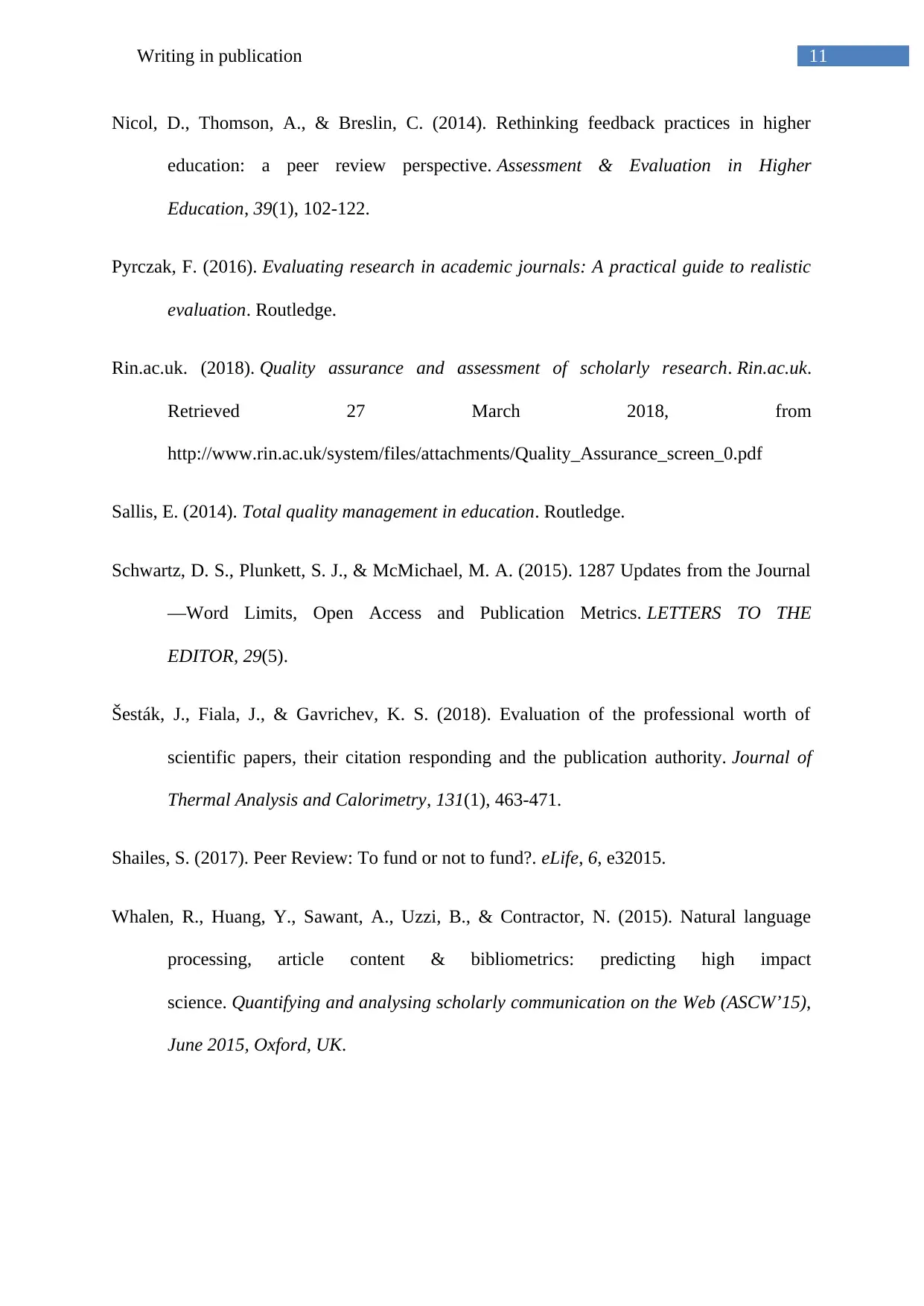
11Writing in publication
Nicol, D., Thomson, A., & Breslin, C. (2014). Rethinking feedback practices in higher
education: a peer review perspective. Assessment & Evaluation in Higher
Education, 39(1), 102-122.
Pyrczak, F. (2016). Evaluating research in academic journals: A practical guide to realistic
evaluation. Routledge.
Rin.ac.uk. (2018). Quality assurance and assessment of scholarly research. Rin.ac.uk.
Retrieved 27 March 2018, from
http://www.rin.ac.uk/system/files/attachments/Quality_Assurance_screen_0.pdf
Sallis, E. (2014). Total quality management in education. Routledge.
Schwartz, D. S., Plunkett, S. J., & McMichael, M. A. (2015). 1287 Updates from the Journal
—Word Limits, Open Access and Publication Metrics. LETTERS TO THE
EDITOR, 29(5).
Šesták, J., Fiala, J., & Gavrichev, K. S. (2018). Evaluation of the professional worth of
scientific papers, their citation responding and the publication authority. Journal of
Thermal Analysis and Calorimetry, 131(1), 463-471.
Shailes, S. (2017). Peer Review: To fund or not to fund?. eLife, 6, e32015.
Whalen, R., Huang, Y., Sawant, A., Uzzi, B., & Contractor, N. (2015). Natural language
processing, article content & bibliometrics: predicting high impact
science. Quantifying and analysing scholarly communication on the Web (ASCW’15),
June 2015, Oxford, UK.
Nicol, D., Thomson, A., & Breslin, C. (2014). Rethinking feedback practices in higher
education: a peer review perspective. Assessment & Evaluation in Higher
Education, 39(1), 102-122.
Pyrczak, F. (2016). Evaluating research in academic journals: A practical guide to realistic
evaluation. Routledge.
Rin.ac.uk. (2018). Quality assurance and assessment of scholarly research. Rin.ac.uk.
Retrieved 27 March 2018, from
http://www.rin.ac.uk/system/files/attachments/Quality_Assurance_screen_0.pdf
Sallis, E. (2014). Total quality management in education. Routledge.
Schwartz, D. S., Plunkett, S. J., & McMichael, M. A. (2015). 1287 Updates from the Journal
—Word Limits, Open Access and Publication Metrics. LETTERS TO THE
EDITOR, 29(5).
Šesták, J., Fiala, J., & Gavrichev, K. S. (2018). Evaluation of the professional worth of
scientific papers, their citation responding and the publication authority. Journal of
Thermal Analysis and Calorimetry, 131(1), 463-471.
Shailes, S. (2017). Peer Review: To fund or not to fund?. eLife, 6, e32015.
Whalen, R., Huang, Y., Sawant, A., Uzzi, B., & Contractor, N. (2015). Natural language
processing, article content & bibliometrics: predicting high impact
science. Quantifying and analysing scholarly communication on the Web (ASCW’15),
June 2015, Oxford, UK.
⊘ This is a preview!⊘
Do you want full access?
Subscribe today to unlock all pages.

Trusted by 1+ million students worldwide
1 out of 13
Related Documents
Your All-in-One AI-Powered Toolkit for Academic Success.
+13062052269
info@desklib.com
Available 24*7 on WhatsApp / Email
![[object Object]](/_next/static/media/star-bottom.7253800d.svg)
Unlock your academic potential
Copyright © 2020–2025 A2Z Services. All Rights Reserved. Developed and managed by ZUCOL.





